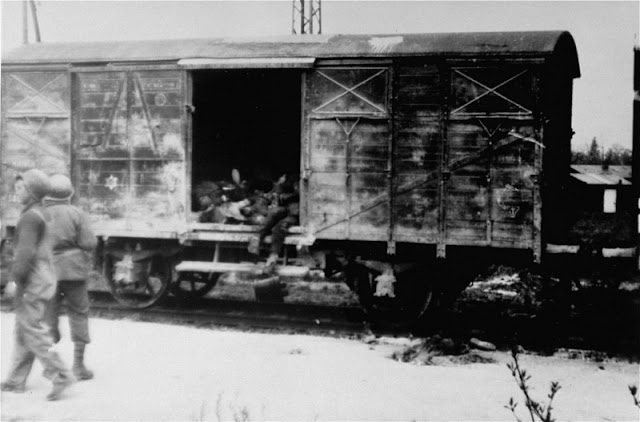The “Death Train” was a transport train that arrived at Dachau on April 27, 1945 after a 20 day trip, bringing prisoners from the Buchenwald concentration camp. Most stories about the train do not mention that there were survivors who entered the Dachau camp and were liberated two days later by American soldiers.
Private John Lee, a 45th Division soldier who was one of the first men on the scene, was quoted by author Sam Dann in his book entitled
Dachau 29 April 1945: The Rainbow Liberation Memoirs:
“These people were stuffed in these cars. The cars had bullet holes all over them, evidently from strafing on the way to Dachau. Most of the GIs just stood there in silence and disbelief. We had seen men in battle blown apart, burnt to death, and die many different ways, but we were never prepared for this. Several of the dead lay there with their eyes open, a picture I will never get out of my mind. It seems they were looking at us and saying, ‘What took you so long?'”
In a book entitled
The Last Days of Dachau, written by Dr. Ali Kuci, a Dachau survivor from Albania, and Arthur Haulot, a Belgian political prisoner at Dachau, the authors wrote that the train had arrived at noon on April 27, 1945 with 1,600 survivors out of 2,400 prisoners who had started on the journey from Weimar. Marcus J. Smith wrote that these figures were changed, after the war ended, to 2,000 to 2,500 survivors out of 6,000 who had been put on the train. The change in the numbers was made because a typical transport of prisoners consisted of 60 cars with 100 prisoners in each car.
The strafing of the “Death Train” while the train was on its way from Buchenwald to Dachau was mentioned in the American Military Tribunal proceedings against Hans Merbach, the SS man in charge of the ill-fated train.
Hans Merbach was the 35-year-old SS man assigned to supervise the evacuation of Buchenwald prisoners to Dachau in an effort to prevent them from being released by the American liberators. The Nazis feared that the prisoners, if released, would go to the nearby city of Weimar and attack German civilians.
The “Death Train” left the Weimar train station on April 8, 1945 but didn’t arrive at Dachau until almost three weeks later because of delays caused by Allied bombing of the train tracks. By that time, many of the prisoners were dead.
 |
| Picture was taken by Major Clarence L. Benjamin at the instant a few of the train people saw the tanks and first realized they had been liberated. |
 |
| On the hill to the left are people resting – some forever. Some sixteen died of starvation before food could be brought to the train. |
 |
| This train which contained about 2,500 Jews, had a few days previously left the Bergen-Belsen death camp. |
 |
| The little fellow was pleased at having his picture taken. |
 |
| They were crammed into all available space and the freight cars were packed with about 60 – 70 people. |
 |
| The attempt was evidently to get them to a camp where they could be eliminated before they could be liberated. |
 |
| This is Gina Rappaport, who spoke very good English and spent a couple of hours telling her story to the American troops. She was in the Warsaw ghetto under terrible conditions, and then was sent to Bergen-Belsen. |
 |
| Prisoners from an evacuation train from Bergen-Belsen pose next to a railroad car in Magdeburg. This photo was probably taken a few days after liberation since written on the side of the car is "Bergen-Belsen" and "We are going to Israel by way of France." Pictured are the donor's stepfather, Chil Elbaum (back center), Maurice (second from the right), Esther (standing third from the right) and Chaim Elbaum (sitting on the far left). |
 |
| American soldiers of the U.S. 7th Army force boys believed to be Hitler youth to examine boxcars containing bodies of prisoners starved to death by the SS. |
 |
| American troops of the US 7th Army force suspected members of the Hitler Youth to view the Dachau death train. |
 |
| View of the Dachau death train in the newly liberated concentration camp. This photo shows: These cars are loaded with bodies of prisoners who died on the trip from another concentration camp to Dachau prison. They died mainly of starvation." |
 |
| German civilians help evacuate survivors from the Schwandorf death train. |
 |
| American soldiers remove one of the few survivors from the Dachau death train. Pictured carrying the survivor is T/4 Sgt. Tony Cardinale and Lieutenant Gerald C. Caskey can be seen speaking to the armed man on the right. |
 |
| American soldiers view the bodies in one of the open railcars of the Dachau death train. |
 |
| American soldiers view the Dachau death train. |
 |
| American soldiers, including a photographer carrying a camera and tripod, view the Dachau death train. |
 |
| American soldiers view one of the railcars of the Dachau death train. |
 |
| The death train in Dachau. |
 |
| Photo of train from Dr. Van Heely collection. Probably US Army, photographer unknown, Sat. April 14, 1945. |
 |
| Survivor poses for photo with the man who rescued him. |



























